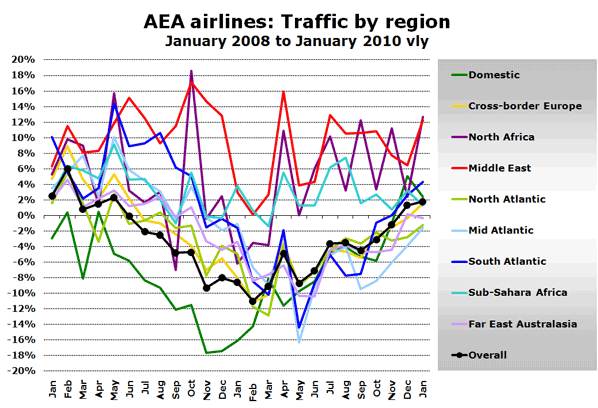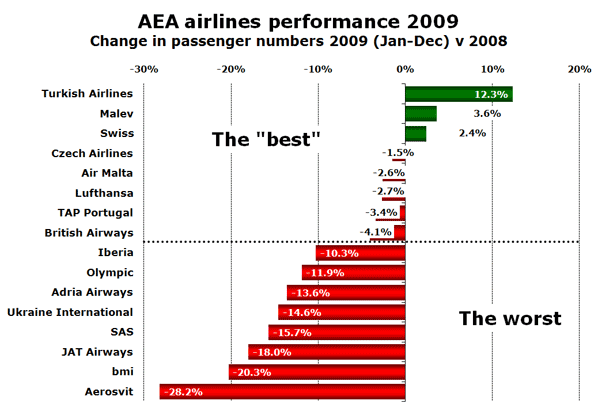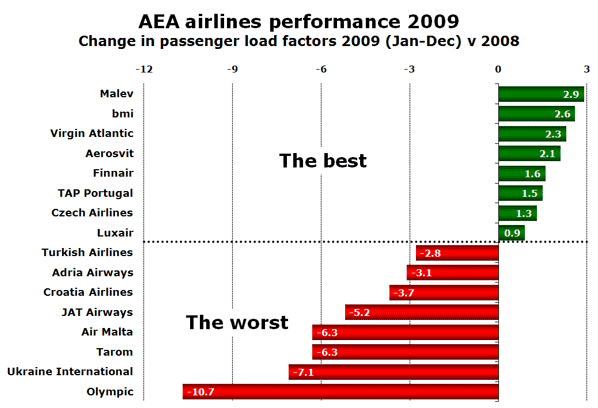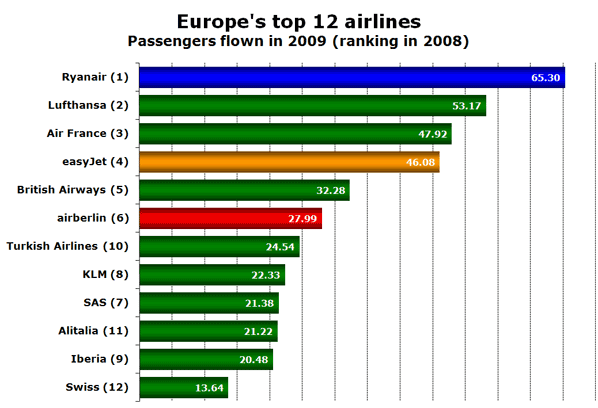14.4.2010 (Anna Aero)
http://www.anna.aero/2010/03/23/aea-passenger-numbers-down-5-8pc-in-2009/
Traffic statistics for the carriers belonging to the
Association of European Airlines (AEA) reveal that passenger numbers fell by
-5.8% in 2009. Traffic as measured in RPKs (revenue passenger kilometres) only
fell by -4.5% while capacity as measured in ASKs (available seat kilometres)
fell just -4.2% resulting in the average load factor falling by 0.3 percentage
points to 76.0%.
During the second half of 2009 the traffic declines were not as great and by December passenger numbers were up once more on a year-over-year comparison, thanks to a two percentage point improvement in load factor. This trend has continued into 2010 with capacity down 2% in January but passenger numbers up 1.8% resulting in a 2.5 percentage point load factor improvement.
The recovery in traffic was driven by the stabilisation in demand for cross-border European traffic and a return to growth in the domestic market. Traffic to Asia and North America is still down on a year-over-year basis.

Passenger numbers on routes to and from the Middle East continued to grow by between 6% and 12% during the second half of 2009 with African routes also reporting increased demand.
A look at passenger numbers across the 28 member airlines reporting shows that just three (Turkish Airlines, Malev and Swiss), reported an increase in passenger numbers in 2009.

Four airlines saw passenger numbers drop by more than 15%. These were Aerosvit (Ukraine), bmi (UK), JAT Airways (Serbia) and SAS (Scandinavia). In January 2010 Turkish Airlines reported a 27% increase in passengers and a 37% increase in traffic (RPKs) thanks to its growing long-haul network. Traffic was also up significantly at Alitalia (+25.9%), Tarom (+23.8%), Icelandair (+22.3%), and LOT (+15.3%).

A comparison of average load factors in 2009 with 2008 reveals that some of those airlines who cut capacity most (Aerosvit and bmi) also saw their load factors improve by the largest amount. Malev’s achievement is laudable as it not only increased passenger numbers by 3.6% but also managed to improve its load factor by 2.9 percentage points. However, capacity (ASKs) was actually down 17% after the airline abandoned its long-haul flying during 2008.
The poorest year-round load factors were reported by JAT (55.4%), Tarom (55.6%) and Olympic Air/Airlines (58.5%). KLM had the best annual load factor at 81.3%, ahead of Swiss (80.1%).
Ryanair stretches lead over Lufthansa in passenger numbers
AEA member airlines claim nine of the top 12 positions among Europe’s largest airlines (as measured in passenger numbers) in 2009. However, three of the top six positions are filled by non-AEA airlines with Ryanair leading the way with over 65 million annual passengers.

The top six positions have remained unchanged since last year but Turkish Airlines has risen three places from tenth to seventh. Iberia and SAS have both slipped two places while the ‘new’ Alitalia has overtaken Iberia for tenth place.
http://www.anna.aero/2010/03/23/aea-passenger-numbers-down-5-8pc-in-2009/